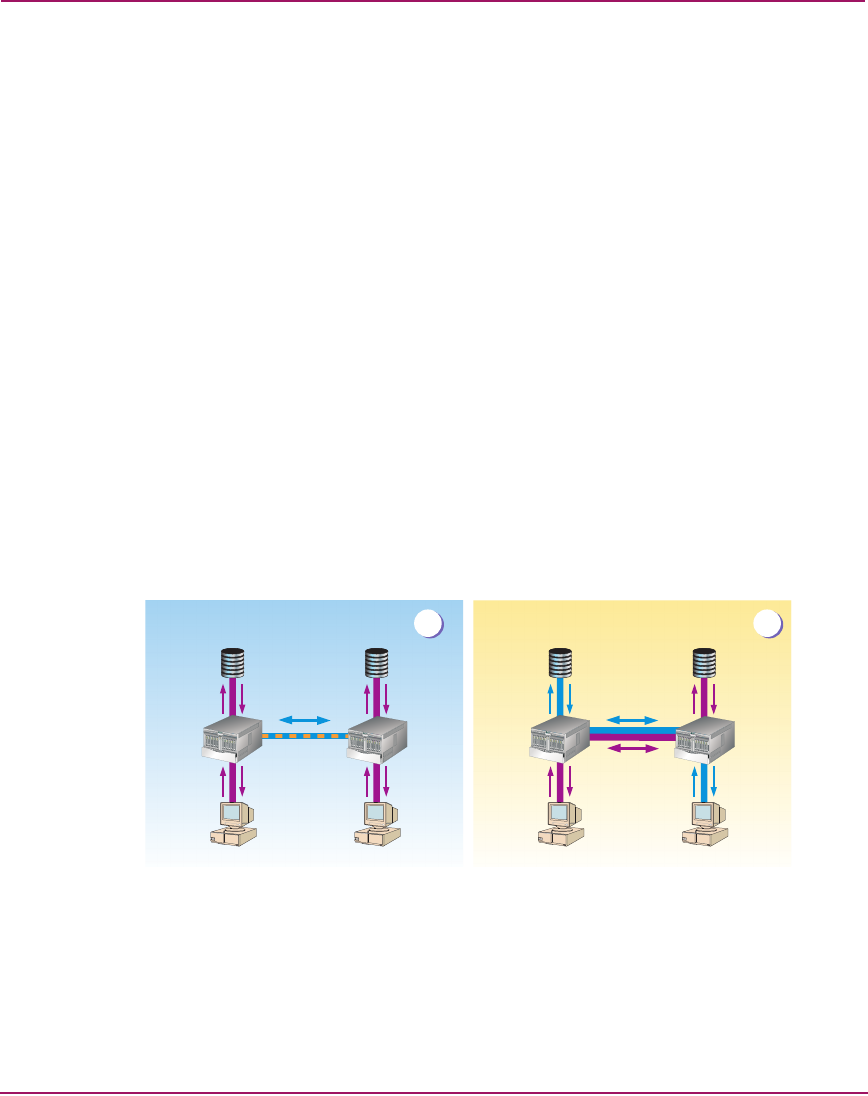FW V06.XX/HAFM SW V08.02.00 HP StorageWorks SAN High Availability Planning Guide (AA-RS2DD-TE, July 2004)
Table Of Contents
- SAN HA Planning Guide
- Contents
- About this Guide
- Introduction to HP Fibre Channel Products
- Product Management
- Planning Considerations for Fibre Channel Topologies
- Fibre Channel Topologies
- Planning for Point-to-Point Connectivity
- Characteristics of Arbitrated Loop Operation
- Planning for Private Arbitrated Loop Connectivity
- Planning for Fabric-Attached Loop Connectivity
- Planning for Multi-Switch Fabric Support
- Fabric Topologies
- Planning a Fibre Channel Fabric Topology
- Fabric Topology Design Considerations
- FICON Cascading
- Physical Planning Considerations
- Port Connectivity and Fiber-Optic Cabling
- HAFM Appliance, LAN, and Remote Access Support
- Inband Management Access (Optional)
- Security Provisions
- Optional Features
- Configuration Planning Tasks
- Task 1: Prepare a Site Plan
- Task 2: Plan Fibre Channel Cable Routing
- Task 3: Consider Interoperability with Fabric Elements and End Devices
- Task 4: Plan Console Management Support
- Task 5: Plan Ethernet Access
- Task 6: Plan Network Addresses
- Task 7: Plan SNMP Support (Optional)
- Task 8: Plan E-Mail Notification (Optional)
- Task 9: Establish Product and HAFM Appliance Security Measures
- Task 10: Plan Phone Connections
- Task 11: Diagram the Planned Configuration
- Task 12: Assign Port Names and Nicknames
- Task 13: Complete the Planning Worksheet
- Task 14: Plan AC Power
- Task 15: Plan a Multi-Switch Fabric (Optional)
- Task 16: Plan Zone Sets for Multiple Products (Optional)
- Index

Planning Considerations for Fibre Channel Topologies
102 SAN High Availability Planning Guide
■ Install an additional ISL — A second ISL can be installed to balance the
traffic load between fabric elements. Two ISLs are sufficient to support the
bandwidth of both NT servers operating at peak load.
■ Upgrade the existing ISL — Fabric element software, firmware, and
hardware can be upgraded to support a 2.125 Gbps bandwidth traffic load
between fabric elements. A 2.125 Gbps ISL is sufficient to support the
bandwidth of both NT servers operating at peak load.
■ Deliberately employ ISL oversubscription — Real-world SANs are
expected to function well, even with oversubscribed ISLs. Device I/O is
typically bursty; few devices operate at peak load for a significant length of
time, and device loads seldom peak simultaneously. As a result, ISL
bandwidth is usually not fully allocated, even for an oversubscribed link. An
enterprise can realize significant cost savings by deliberately designing a
SAN with oversubscribed ISLs that provide connectivity for noncritical
applications.
Device Locality
Devices that communicate with each other through the same director or switch
have high locality. Devices that must communicate with each other through one or
more ISLs have low locality. Part (A) of Figure 42 illustrates high device locality
with little ISL traffic. Part (B) of Figure 42 illustrates low device locality.
Figure 42: Device locality
Although it is possible to design a SAN that delivers sufficient ISL bandwidth in a
zero-locality environment, it is preferable to design local, one-to-one connectivity
for heavy-bandwidth applications such as video server, seismic data processing,
or medical 3D imaging.
A
B
T
M
T
M
High Device Locality
T
M
T
M
Low Device Locality
ISL
ISL
Low Traffic
High Traffic










